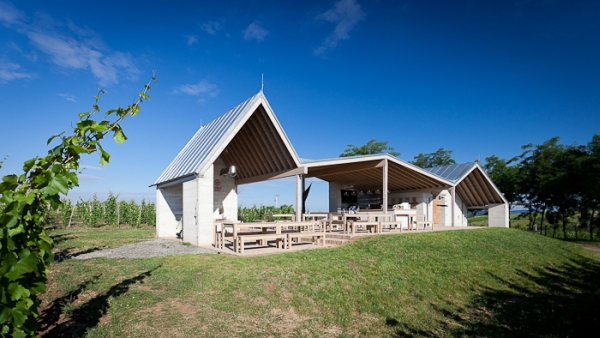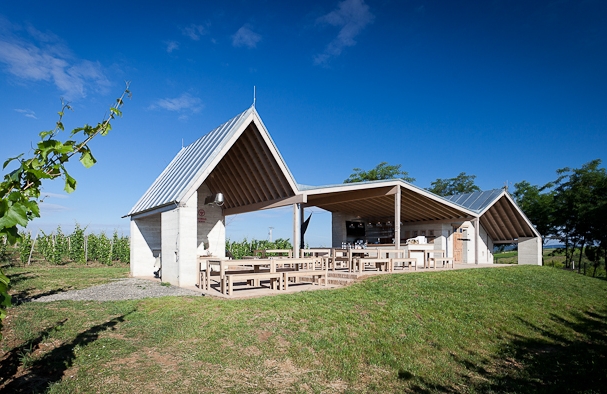From Forms to Materials and Back
Archbishop Vineyards, Almagyar – Wine Terrace and Vine Spa, Eger
Architects: Péter Gereben, Balázs Marián
Text: Levente Szabó
Photos: Zsolt Frikker

The annual architectural survey of Hungarian winery at the turn of the millennium and in the 2000s gave us the impression that every possible aspect and architectural concept has already been applied and tried out – including regional tendencies, archetypal forms, experiments to translate the sacred into architecture, fetishism of the materials used, the means and tools of monumentality and narration as well as expressions of forms, to name a few with no claim of being exhaustive. The complex we are going to analyze here reflects a fresh and new approach. Its freshness comes from an experimental and innovative selection of forms and materials, whilst its novelty lies in the parallel appearance and momentums of these two tendencies. Thus when we are just about to engage in an analysis of forms, the materials used shall attract our attention, and before we could immerse in the delicacies of material reality that affect our senses, forms push into the foreground all of a sudden. This kind of positive uncertainty is probably the most significant architectural virtue of the buildings belonging to the Archbishop Vineyards in Almagyar.
The wine terrace in Eger and its outbuildings feature a composition which is based on a basically illustrative and almost theatrical concept. Evoking archetypal open-closed houses which are crammed together, the wine terrace functions as a centre surrounded almost concentrically by house-huts with hip roofs running in the same direction, whilst the basin and the lookout set in a corner of the vineyard contribute to the complex as object-like components. The degree of abstraction is even more intense when approaching the lookout from the huts through the wine terrace and back: its system of references involves the lookout as the widest spectrum (tree-stand, sign, barn), the wine terrace as its most complex constituent (an open shed, rows of houses, undulating roof, taut tent) and the huts as the most concrete components (press-sheds and keeper huts).
The huts of Gereben and Marián are self-identical, being contemporary transcriptions of structures that had once stood in this vineyard. When viewed from a distance, these three small houses look identical. However, on closer inspection, they show minor differences. Featuring a structure which integrates walls and pillars, the wine terrace reveals a cluster of three house typologies with a different pitch crammed together, although they offer a variety of interpretations: we may just as well associate it with a tarp stretched between the two extreme walled masses as well as an open shed. As a result of their configuration, the structure of masses is a well-known topos in contemporary international and Hungarian architecture. However, what we face here is neither a building nor an object-oriented form which is obviously like a sign functioning as a central component of the complex. It is here that one may trace most obviously the intentions of an architect, which is even more evident in the lateral views that appear more powerful as a result of their oblique floor-plan.
The materials used for these buildings have in-depth associations affecting our senses as well as an easily interpretable formal composition. Mixed with concrete, limestone and tuff debris from Kisnána conveys similar multi-layered meanings and contents to the technology of adobe construction with wet mud bricks and layered formwork. The tin-roof thick adobe-walled 18th-century press-shed with a round floor-plan in the neighbourhood in Vécseyvölgy Street may as well be regarded as the prototype of huts in Almagyar. However, it was Evlia Cselebi Turkish globe-trotter who first described the adobe huts of the region along the vineyards of Eger in the 17th century, even though they all had timber roofs. These analogies remain hidden from the visitors and yet embody an affinity with their well-proportioned development and forms, simple and yet characteristic materials that lend local character to the whole complex.
A basic means of these buildings is the tension between the materials used and the forms entailed. When viewing the buildings, one has the impression that they embody the basic elements in Gottfried Semper’s system, especially the earthworks and the roofing as the raw stone concrete walls evoke adobe technology whilst the light timber roofing reveal basically different configurations with a sharp contrast. Of course all this is only appears so because the concept is made up by basic architectural means and the tension developing between them is actually the source of power that the buildings of the complex feature. It is especially evident on the wine terrace the walls of which stand so sparsely that they rate more like bodies or pillars, and thus the undulating roofing takes over prominance instead. Simultaneously with this, a kind of archetypal and timeless spatial formation – which we have seen on the huts – evoke a flowing spatial structure: with this an almost composite structuring gains significance concerning forms as well as materials.
Connotations of materials as well as their uses thus cause an intellectual and sensual experience at the same time whilst transcending the practice of building in a wineyard into a pathetic way of expression. However, many architectural turns help to avoid this impression in a welcome way. Opening up the single space of the huts with the tailor-made and yet commercial garage door allows for a casual and yet astounding approach in the positive sense. A similar twist is achieved by the sophisticated designs of hip roofs and the gutters that overrun in an almost careless manner, much in the same way as outdoor showers and wash-basins side made from individually bent tubes as well as the whole typography painted onto the walls and stone concrete surfaces with paint-sprays. Although the orientation, forms and even the materials of the complex adjust to the series of Hungarian winery buildings suggesting the sacred quality which are often celebrated this development gives us an even more intense impression of the natural in a paradoxical way, which is a result of an experimental approach. Without any kind of pathos, these structures have self-evidently evolved into the man-made components of the vineyards. Of the vineyard it is mainly and only the roofs that are exposed and thus visible.
Architects: Péter Gereben, Balázs Marián – Gereben Marián Építészek Kft.
Fellow architects: Gergely Álmos, Tamás Mezey
Structure: Zoltán V. Nagy
HVAC: Olivér Mészáros
Electrical engineering: István Paizs
Interiors: Kálmán Nyilas
Graphics: Péter Mészáros
Main contractor: Imre Mészáros
Client: Imre Csernus, Ferenc Csutorás, Péter Mészáros – Almagyar Érseki Szőlőbirtok Kft.








